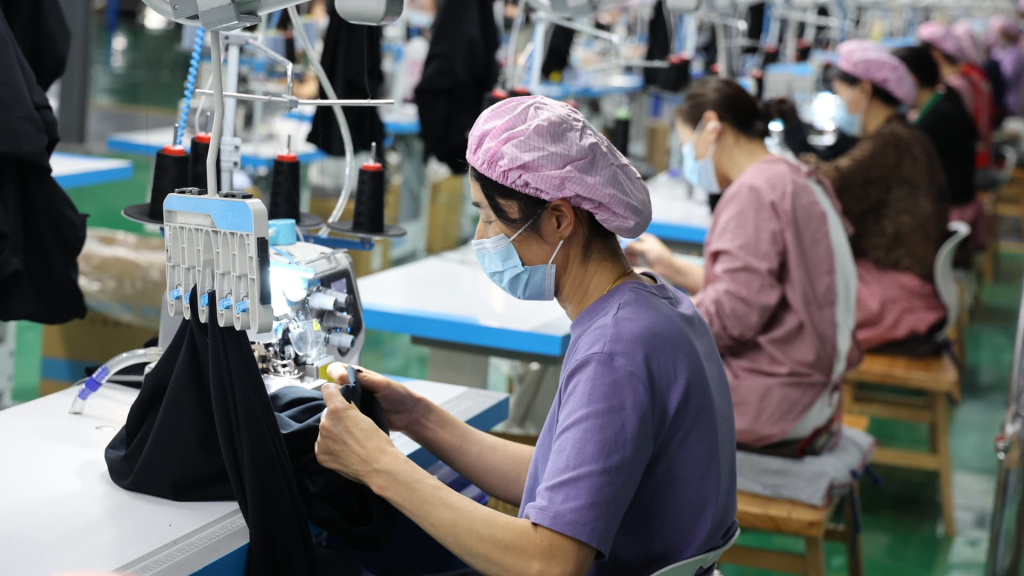BEIJING — China’s manufacturing sector is experiencing a significant slowdown as producers minimize operations and pivot towards new markets due to the escalating effects of U.S. tariffs, according to industry sources and analysts.
This downturn is beginning to affect employment levels across the nation.
“Several factories have recently instructed many of their employees to remain at home for a few weeks and have halted most production activities,” stated Cameron Johnson, a senior partner at Tidalwave Solutions based in Shanghai. Johnson noted that manufacturers in the toy, sporting goods, and low-cost retail segments are facing the brunt of these changes.
“Though these trends are not yet widespread, they are manifesting in key export hubs like Yiwu and Dongguan, with rising concerns that the situation may worsen,” he added. “There is optimism that tariffs might be reduced, allowing for a resumption of orders, but as it stands, companies are resorting to employee furloughs and idling production lines.”
Goldman Sachs estimates indicate that between 10 and 20 million workers in China are involved in export-oriented businesses directed at the U.S. The official figure recorded last year for urban employment in China was 473.45 million.
This month, the U.S. imposed tariffs exceeding 100% on Chinese goods, prompting reciprocal measures from Beijing. While President Donald Trump claimed that trade negotiations with China are ongoing, Chinese officials have disputed the notion of any current talks.
Ash Monga, founder and CEO of Imex Sourcing Services in Guangzhou, suggested that the repercussions of the recent tariff hikes are “far greater” than those experienced during the Covid-19 pandemic. He pointed out that for smaller enterprises with limited financial resources, the abrupt escalation in tariffs may prove catastrophic.
In response to the overwhelming demand from clients and other importers of Chinese goods, Monga announced the launch of a new “Tariff Help” website to assist small businesses in finding suppliers outside of China.
Livestreaming
The disruption in business operations is compelling Chinese exporters to adopt innovative sales tactics.
Woodswool, an athletic apparel manufacturer located near Shanghai in Ningbo, has swiftly transitioned to online sales through livestreaming. Within a week of launching this new sales channel, the company reported over 30 orders, generating a gross merchandise value exceeding 5,000 yuan (approximately $690).
This is a modest attempt to recapture lost sales.
“All our U.S. orders have been canceled,” said Li Yan, Woodswool’s factory manager and brand director, communicating in Mandarin. “Before this, more than half of our production was destined for the U.S., and we anticipate some of our capacity will remain idle for two to three months as we seek to establish new markets.” Li noted that the company has had two decades of business relationships with clients in Europe, Australia, and the U.S.
The shift towards livestreaming aligns with efforts from major Chinese technology firms, as urged by the government, to help exporters redirect products to the domestic market.
Woodswool is leveraging Baidu’s platform, which integrates a search engine with livestreaming e-commerce. Li opted for Baidu’s virtual human livestreaming feature due to its quick implementation timeframe, avoiding extensive costs associated with studio renovations and hiring staff.
Baidu has collaborated with numerous Chinese businesses to establish domestic e-commerce channels after recently announcing subsidies and complimentary AI tools—like its “Huiboxing” virtual humans—to support around 1 million businesses. These AI-driven avatars simulate sales pitches and customer interactions, which Baidu claims yield a higher return on investment compared to human representatives.
Domestic market challenges
Nonetheless, the pledged amount of $27.22 billion constitutes only 5% of the $524.66 billion worth of goods that China shipped to the U.S. in the previous year.
“Some businesses have informed us that the current 125% tariffs have rendered their business models unfeasible,” reported Michael Hart, president of the American Chamber of Commerce in China. He noted an increase in competition among local companies over the past week.
Hart predicts that tariffs from both nations will likely persist at certain levels, with specific exemptions being made. “That’s the trajectory they are heading towards,” he remarked.
Products designed for the suburban U.S. market may not seamlessly transition to cater to the needs of urban Chinese consumers.
Manufacturers have also taken to Chinese social media platforms like Red Note and Douyin, the domestic version of TikTok, to call for consumer support. However, fatigue among the audience is becoming apparent, as pointed out by Ashley Dudarenok, founder of ChoZan, a China marketing consultancy.
Looking outside the U.S.
Increasing scrutiny from the U.S. over transshipments has made it less appealing for Chinese companies to reroute exports to the U.S. through third countries. Dudarenok noted that many businesses are shifting production to India rather than Southeast Asia, while also focusing their efforts on customers in Europe and Latin America.
Some firms have already established trade routes that bypass traditional chains from China.
Liu Xu, who operates an e-commerce business named Beijing Mingyuchu, specializes in selling bathroom products to Brazil. Despite facing challenges due to fluctuating exchange rates and rising shipping costs, Liu remains optimistic that trade with Brazil will be largely insulated from the tensions between China and the U.S.
Trade between China and Brazil has surged, doubling between 2018 and 2024, and similar growth has been observed in exports to Ghana.
During the pandemic, Cotrie Logistics was established in Ghana to facilitate sourcing, coordinate shipments amidst delays, and strengthen reliable logistics routes, reported CEO Bright Tordzroh. His company, which primarily manages trade between China and Ghana, currently generates annual revenues ranging from $300,000 to $1 million.
The trade tensions between the U.S. and China have prompted many companies to explore sourcing and manufacturing options beyond U.S. borders, a development Tordzroh anticipates will yield new opportunities for Cotrie.


























